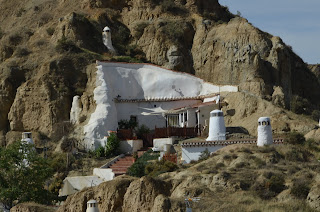Pages
Thursday, October 29, 2020
Petra: Why it is Deemed one of the 7 Ancient Wonders of the World
Wednesday, October 21, 2020
Guadix: A City of Cave Dwellers in Southern Spain
Today, almost 19,000 people live in Guadix, many of them inhabiting 4,000 caves as permanent homes in and closeby to the town. An attraction to living underground is a year 'round temperature of sixty-six degrees Fahrenheit (19 degrees Celsius) in an arid climate that can reach the high 90s F in summer (35 c) and get down to the low 20's (-6 c) in winter. Rather than a dank, dark environment, the caves have been modernized, some of them turned into luxurious dwellings, and some have even been converted into hotel accommodations for visitors who would like the experience. The area is considered to have the biggest concentration of inhabited caves in Europe.
or reload the browser
Wednesday, October 14, 2020
Dingle, Ireland to Georgetown, Colorado and the Rocky Mountains, Part II
The Spanish Conquistadores occupied Colorado in the seventeenth-century and annexed it into the province of Santa Fe de Nuevo México as part of the Viceroyalty of New Spain. It wasn’t until 1846 when the United States went to war with Mexico that a treaty was finally reached in 1848, giving the territory to the United States.
Most white settlers avoided the rugged terrain, until 1858 when a
party from California discovered gold around Pikes Peak. More than one thousand
people converged on the Territory of Colorado to find gold. Within a decade, hard
rock gold, silver, and other minerals, including coal, gave impetus for
prospecting. Some grew rich; most didn’t. Immigrants from Scandinavia, Scotland,
Ireland, Italy, Germany, and Russia provided labor for mining, railroads, and
farming. Experts in mining technology from Europe flocked to exploit the land. In
August 1876, Colorado officially became the thirty-eight state of the union.
When the Spanish first arrived, they set up a system of trade with Native Americans, and between 1832 - 1856 traders, trappers, and settlers established trading posts along the Arkansas, South Platte, and Sain Vrain Rivers, carrying on a robust trade. Most prominent among them were the Cheyenne, Arapaho, and Ute who lived on the plains and moved west along the Front Range of the Colroado mountains, or in the south near New Mexico. These people had their own colorful culture, customs, and religious traditions.
Yet, with immigration came increased pressures for land and resources. Native Americans were pushed off their lands, their sacred burial grounds trampled, diseases like tuberculosis raged through their tribes, and treaties were signed and broken. Cheyenne and Arapaho joined forces against the calvary as skirmishes took place, the two deadliest being the Sand Creek (1864) and Summit Springs (1869) against the Native Americans. Though eventually Native Americans reluctantly accepted reallocation to reservations, strife continued through the twentieth century.
In the twenty-first century, great strides have been made to educate people about Native American culture and traditions, such as the Denver Indian Market & Southwest Art Fest held every January to bridge the gap. If the history of humanity teaches us anything, it ought to be to value and respect all human life, created in the image of God, wherever it may be found.
or reload the browser
or reload the browser
or reload the browser
Wednesday, October 7, 2020
New Blog Series Travels to the Past and Explores Our History
The Dingle Peninsula provides you with a sense of awe and inspires the imagination. You can easily understand how hard it would have been for Anna to leave her beloved land.
or reload the browser



























